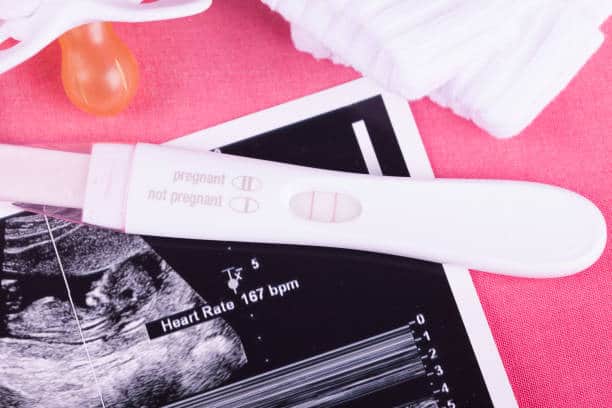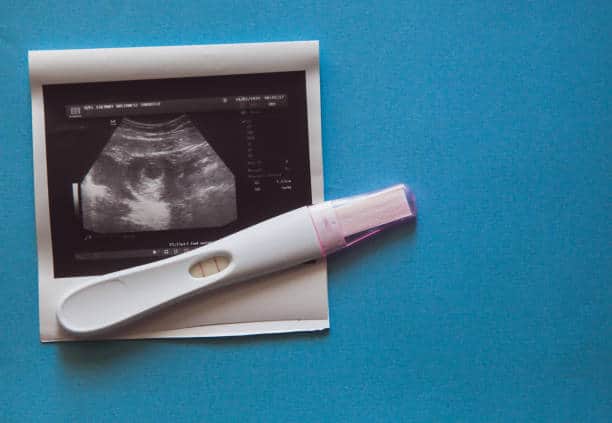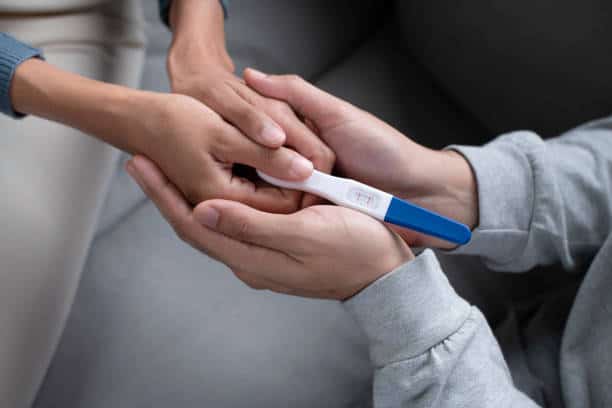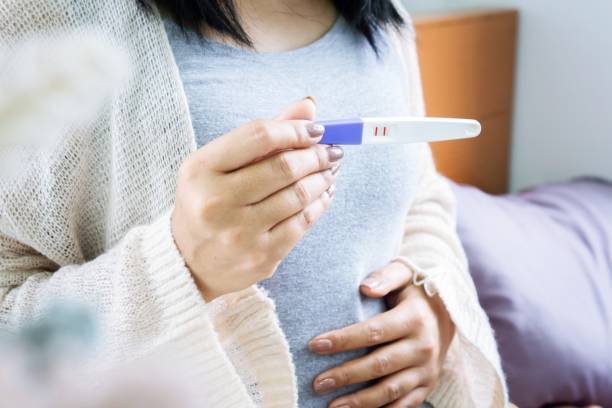Dye stealer is a term used to describe a pregnancy test result where the test line is darker than the control line. It usually occurs when the pregnancy hormone hCG is very high.
While this phenomenon is not widely known, it has gained popularity among women who are trying to conceive and those who have experienced pregnancy loss. One common question among women is whether is a dye stealer at 5 weeks a good sign.
A dye stealer occurs when the test line on a pregnancy test is darker than the control line. It is a result of high levels of hCG in the body, which is produced during pregnancy.
The occurrence of a dye stealer is rare and is usually seen in women who are further along in their pregnancy. However, some women have reported experiencing a dye stealer as early as 5 weeks of pregnancy.
Many women wonder if a dye stealer at 5 weeks is a good sign of a healthy pregnancy. While the occurrence of a dye stealer is generally a positive sign, it is not a definitive indicator of a healthy pregnancy.
Other factors such as pregnancy symptoms, medical conditions, and medication use can affect the accuracy of a pregnancy test. Additionally, a dye stealer can occur in multiple pregnancies or in cases of molar pregnancy, which is a rare condition where abnormal tissue grows in the uterus.

1. Understanding Dye Stealer

A dye stealer is a term used to describe a pregnancy test result where the test line is darker than the control line. This occurs when the level of human chorionic gonadotropin (hCG) in the urine is so high that it saturates the antibodies on the test strip, causing the dye to be pulled away from the control line and into the test line.
This results in a darker test line and a lighter control line, giving the appearance of a “steal” of the dye.
Dye stealers are commonly seen on First Response Early Result (FRER) tests, which are known for their sensitivity to low levels of hCG. However, they can also occur on other types of pregnancy tests.
It is important to note that a dye stealer is not a guarantee of a healthy pregnancy, but rather an indication of high levels of hCG.
It is recommended to follow the instructions provided with the pregnancy test to ensure accurate results. Waiting until the recommended time frame before checking the result can prevent false positives or false negatives.
It is also important to note that dye stealers may occur later in pregnancy as well, so a lack of a dye stealer at 5 weeks does not necessarily indicate a problem.
In summary, a dye stealer on a pregnancy test can be a positive sign, indicating high levels of hCG and a possible healthy pregnancy. However, it is not a guarantee and should be confirmed with a healthcare provider.
It is important to follow test instructions and wait until the recommended time frame to check the result for accuracy.
2. Significance of Dye Stealer at 5 Weeks

When a woman takes a pregnancy test, it measures the level of human chorionic gonadotropin (hCG) hormone in her urine. This hormone is produced by the placenta after a fertilized egg implants in the uterus.
A positive pregnancy test indicates that a woman is pregnant and that her hCG levels are rising.
At 5 weeks pregnant, a dye stealer on a pregnancy test can be a good sign. A dye stealer is when the test line is so dark that it steals the dye from the control line, making it appear lighter.
This indicates that the woman’s hCG levels are high and rising, which is a positive sign for a healthy pregnancy.
However, it is important to note that the presence or absence of a dye stealer does not necessarily indicate the health of the pregnancy. The hCG levels can vary greatly from woman to woman and from pregnancy to pregnancy.
A dye stealer is simply an indication of high hCG levels at the time of testing.
It is also important to note that not all pregnancy tests are created equal. Some tests are more sensitive than others and can detect lower levels of hCG.
A woman may get a dye stealer on one brand of test but not on another. It is recommended to confirm a positive pregnancy test with a healthcare provider and to have regular prenatal care to monitor the health of the pregnancy.
Overall, a dye stealer at 5 weeks can be a positive sign, but it is not a guarantee of a healthy pregnancy. It is important to follow up with a healthcare provider for proper prenatal care.
3. Correlation Between Dye Stealer and Pregnancy Symptoms

At 5 weeks pregnant, many women start to experience pregnancy symptoms such as nausea, fatigue, and breast tenderness. These symptoms are caused by the hormonal changes that occur during pregnancy, and they can be a good sign that the pregnancy is progressing normally.
One phenomenon that some women may notice is a “dye stealer” on a pregnancy test. A dye stealer occurs when the test line on a pregnancy test is darker than the control line, indicating a high level of the pregnancy hormone hCG in the urine.
Some women may wonder if a dye stealer is a good sign of a healthy pregnancy.
While a dye stealer can be an encouraging sign, it is not a definitive indicator of a healthy pregnancy. The level of hCG in the urine can vary widely from woman to woman, and even from pregnancy to pregnancy in the same woman.
Some women may have a dye stealer and go on to have a healthy pregnancy, while others may not have a dye stealer and have a healthy pregnancy.
It is important to remember that pregnancy symptoms and a dye stealer on a pregnancy test are not the only indicators of a healthy pregnancy. Regular prenatal care, including ultrasounds and blood tests, are necessary to monitor the health of the mother and the developing fetus.
If a woman has concerns about her pregnancy, she should discuss them with her healthcare provider.
4. Dye Stealer and Miscarriage

A “dye stealer” is a term used to describe a pregnancy test result where the test line is darker than the control line. This can occur when the pregnancy hormone, human chorionic gonadotropin (hCG), is present in high levels in the urine.
Some women may see this as a positive sign that their pregnancy is progressing well, but is it a good sign?
Unfortunately, the presence of a dye stealer does not necessarily indicate a healthy pregnancy. In fact, it can be a sign of an impending miscarriage.
When a pregnancy is not developing as it should, the hCG levels may rise initially but then begin to fall. This can result in a dye stealer on a pregnancy test followed by a negative test result as the hCG levels continue to drop.
It’s important to note that not all pregnancies that result in a dye stealer end in miscarriage. Some women may have high levels of hCG throughout their pregnancy, which can result in a dye stealer on a pregnancy test.
However, if a woman experiences any symptoms of miscarriage, such as vaginal bleeding or cramping, she should contact her healthcare provider immediately.
In summary, while a dye stealer can be a positive sign in some cases, it is not a definitive indicator of a healthy pregnancy. Women who experience a dye stealer should continue to monitor their symptoms and seek medical attention if they have any concerns about their pregnancy.
5. Dye Stealer and Multiple Pregnancies

A dye stealer is a term used to describe a pregnancy test result where the control line is lighter than the test line. This occurs when the pregnancy hormone (hCG) is so high that it saturates the test, making the control line appear fainter.
While a dye stealer is generally considered a good sign of a healthy pregnancy, it does not necessarily indicate a multiple pregnancy.
In some cases, a dye stealer can be an early indicator of a twin or multiple pregnancy. This is because a higher level of hCG is typically present in multiple pregnancies compared to singleton pregnancies.
However, a dye stealer can also occur in a singleton pregnancy with high levels of hCG.
It is important to note that a dye stealer should not be used as the sole indicator of a multiple pregnancy. Ultrasound is the most accurate method of determining the number of fetuses present.
Additionally, other factors such as maternal age, family history, and fertility treatments can increase the likelihood of a multiple pregnancy.
In summary, while a dye stealer may be a positive sign of a healthy pregnancy, it is not a reliable indicator of a multiple pregnancy. Ultrasound and other factors should be considered to accurately determine the number of fetuses present.
6. Dye Stealer and Medical Conditions

A dye stealer is a term used to describe a pregnancy test in which the test line is darker than the control line. It is considered a good sign as it indicates a high level of hCG (human chorionic gonadotropin), the hormone produced during pregnancy.
However, a dye stealer can also be a sign of certain medical conditions.
One such condition is Polycystic Ovary Syndrome (PCOS), a hormonal disorder that affects women of reproductive age. Women with PCOS have higher levels of androgens (male hormones) which can cause irregular periods, infertility, and difficulty getting pregnant.
In some cases, women with PCOS may have higher levels of hCG, leading to a dye stealer on a pregnancy test.
Another medical condition that can cause a dye stealer is a molar pregnancy, a rare type of pregnancy in which a tumor develops instead of a fetus. Molar pregnancies can cause high levels of hCG, leading to a positive pregnancy test and a dye stealer.
However, molar pregnancies are often accompanied by other symptoms such as vaginal bleeding and cramping.
It is important to note that a dye stealer alone is not a definitive indicator of a healthy pregnancy. Other factors such as the timing of the test and the sensitivity of the test can also affect the results.
It is recommended to confirm the pregnancy with a healthcare provider and to monitor hCG levels to ensure a healthy pregnancy.
In summary, while a dye stealer on a pregnancy test is generally considered a good sign, it can also be a sign of certain medical conditions such as PCOS and molar pregnancy. It is important to confirm the pregnancy with a healthcare provider and to monitor hCG levels to ensure a healthy pregnancy.
7. Dye Stealer and Testing Accuracy

A dye stealer is a term used to describe a positive pregnancy test where the test line is darker than the control line. This occurs when the test detects a high concentration of human chorionic gonadotropin (hCG) in the urine.
At 5 weeks pregnant, a dye stealer can be a good sign of a healthy pregnancy. However, it is important to note that not all tests are created equal and testing accuracy can vary.
False negatives can occur if the test is taken too early or if the urine is too diluted. It is recommended to take the test with morning urine, as it is more concentrated and will provide more accurate results.
Blood tests and ultrasounds are more accurate ways to confirm a pregnancy, but a dye stealer can still provide reassurance for those who are waiting for their appointment. It is important to remember that every pregnancy is different and a positive pregnancy test does not guarantee a successful pregnancy.
In summary, a dye stealer at 5 weeks can be a good sign of a healthy pregnancy, but it is important to consider testing accuracy and the possibility of false negatives. It is recommended to take the test with morning urine and confirm the pregnancy with a healthcare provider.
8. Dye Stealer and Medication

A dye stealer is a term used to describe a positive pregnancy test where the test line is darker than the control line. It is often seen as a positive sign of a healthy pregnancy, especially when it occurs early on.
However, the use of certain medications can also cause a dye stealer result, which can be misleading.
One medication that can cause a dye stealer is hCG injections. These injections are often given to women undergoing fertility treatments to help stimulate ovulation.
The hCG hormone can remain in the body for several days after the injection, which can cause a positive pregnancy test result, including a dye stealer.
Another medication that can cause a false positive result is progesterone supplementation. Progesterone is often prescribed to women who have a history of miscarriage or who are undergoing fertility treatments.
The hormone can cause pregnancy-like symptoms and can also interfere with pregnancy tests, causing a false positive result.
It is important to talk to a healthcare provider about any medications that are being taken and how they may affect pregnancy test results. In some cases, a blood test may be necessary to confirm a pregnancy and rule out any false positive results.
In conclusion, while a dye stealer can be a positive sign of a healthy pregnancy, it is important to consider any medications that may have been taken and how they can affect pregnancy test results. Talking to a healthcare provider and getting a blood test may be necessary to confirm a pregnancy and ensure accurate results.
9. Getting Pregnant and Dye Stealer

When a woman is trying to conceive, she may become very familiar with the term “dye stealer.” This term refers to a pregnancy test result in which the test line is darker than the control line, indicating a high level of hCG (human chorionic gonadotropin) in the urine.
Some women may see this as a positive sign of a healthy pregnancy, while others may be concerned about the possibility of a molar pregnancy or other complications.
The presence of a dye stealer at 5 weeks pregnant can be a good sign, but it is not a guarantee of a healthy pregnancy. It is important to remember that every woman’s pregnancy is different, and the presence or absence of a dye stealer is not a definitive indicator of the health of the pregnancy.
When trying to conceive, it is important to understand the basics of ovulation and fertility. Ovulation is the process by which an egg is released from the ovary and travels down the fallopian tube, where it may be fertilized by sperm.
Fertility refers to the ability to conceive a child, and can be influenced by a variety of factors, including age, health, and lifestyle.
If a woman has been trying to conceive for several months without success, she may wish to consult a fertility specialist. The specialist can perform tests to determine whether there are any underlying medical issues that may be preventing conception, and can recommend treatments or interventions to improve fertility.
In conclusion, the presence of a dye stealer at 5 weeks pregnant can be a good sign, but it is not a definitive indicator of a healthy pregnancy. When trying to conceive, it is important to understand the basics of ovulation and fertility, and to seek the advice of a medical professional if necessary.
10. Dye Stealer and Family Planning

A dye stealer is a term used to describe a pregnancy test result where the test line is darker than the control line. This happens when the hCG levels in the urine are very high.
In most cases, a dye stealer at 5 weeks is a good sign and indicates a healthy pregnancy.
When it comes to family planning, a dye stealer can be a cause for celebration for couples trying to conceive. It is a positive indication that the pregnancy is progressing well and the baby is growing as expected.
This can bring a lot of joy and excitement to the family, especially for first-time parents.
For those who are not planning to have a baby, a dye stealer can be a surprise and may require some adjustments to their family planning strategies. It is important to seek medical advice and discuss the available options with a healthcare provider.
In terms of baby products and registry builders, a dye stealer can be an important milestone for parents-to-be. This is a good time to start thinking about the baby’s needs and preparing for their arrival.
Parents can start creating a registry of essential baby items and researching the best products for their baby’s health and well-being.
Overall, a dye stealer at 5 weeks is a positive sign for couples trying to conceive and can bring a lot of joy and excitement to the family.
It is important to seek medical advice and discuss any concerns with a healthcare provider.
11. Community Discussion on Dye Stealer

When it comes to pregnancy tests, the term “dye stealer” refers to a result where the test line is darker than the control line. While this may seem like a positive sign, it is important to understand what it means and what it does not mean.
According to the community discussion on dye stealer, many women have reported getting a dye stealer result at 5 weeks pregnant. Some women have even reported getting a dye stealer result as early as 3 weeks pregnant.
However, it is important to note that a dye stealer result does not necessarily indicate a healthy pregnancy or a viable pregnancy.
Some women have reported getting a dye stealer result and then later experiencing a miscarriage. On the other hand, some women have reported getting a negative result and then later finding out they are pregnant.
Therefore, it is important to remember that a dye stealer result is just one piece of information and should not be relied on as the sole indicator of pregnancy.
It is also important to note that not all pregnancy tests are created equal. Some tests may be more sensitive than others and may be more likely to produce a dye stealer result.
It is recommended to use a high-quality pregnancy test and to follow the instructions carefully.
In conclusion, while a dye stealer result may be a good sign, it is important to remember that it is just one piece of information and should not be relied on as the sole indicator of pregnancy. It is recommended to confirm the pregnancy with a healthcare provider and to follow their recommendations for prenatal care.
Related posts:
Frequently Asked Questions
What is a dye stealer and how does it work on a pregnancy test?
A dye stealer occurs when the pregnancy test line is darker than the control line. This happens when the pregnancy hormone (hCG) levels are very high. Pregnancy tests work by detecting hCG in the urine. The test contains a dye that changes color in the presence of hCG, indicating a positive result.
Is it common to get a dye stealer on a pregnancy test at 5 weeks?
It is not common to get a dye stealer on a pregnancy test at 5 weeks. In fact, it is quite rare. Most women will not have high enough levels of hCG to produce a dye stealer until later in pregnancy.
Does a dye stealer on a pregnancy test indicate a healthy pregnancy?
A dye stealer on a pregnancy test does not necessarily indicate a healthy pregnancy. It simply means that the hCG levels are very high. A healthy pregnancy can still have low hCG levels, and a high hCG level does not guarantee a healthy pregnancy.
Can a dye stealer on a pregnancy test disappear or get lighter?
Yes, a dye stealer on a pregnancy test can disappear or get lighter. This can happen if the hCG levels start to decrease. It can also happen if the test is read after the recommended time frame, as the dye may start to evaporate.
What does it mean if the pregnancy test line is getting darker than the control?
If the pregnancy test line is getting darker than the control, it means that the hCG levels are increasing. This is a good sign and indicates a healthy pregnancy.
When should the pregnancy test line be darker than the control?
The pregnancy test line should be darker than the control when the hCG levels are high enough to produce a positive result. This can happen as early as a few days after a missed period, but it is more common a week or two later.

Iesha is a loving mother of 2 beautiful children. She’s an active parent who enjoys indoor and outdoor adventures with her family. Her mission is to share practical and realistic parenting advice to help the parenting community becoming stronger.
